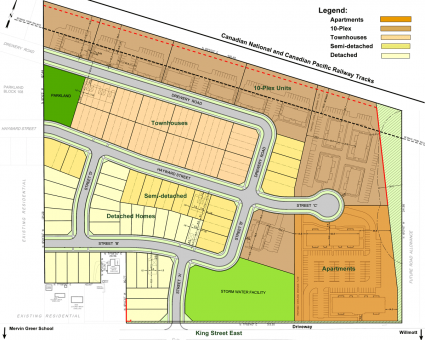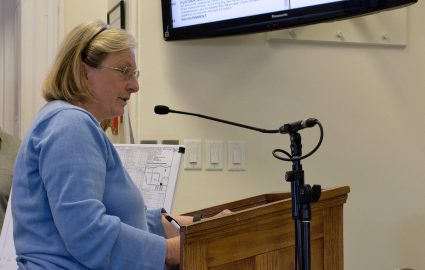Stalwood Homes is currently building and selling homes in the East end at Brook Road north of King Street and south of the railway tracks. This is now at Phase 3 (of 4) of East Village. They own the land to the East of that and have now submitted an application for approval of a draft plan of subdivision for 333 housing units in that area which will be called East Village Phase 5. This will require rezoning and an Official Plan amendment for the part of that area where a high density apartment block is proposed. Because of that, a public meeting was held on Monday, June 24 to allow the public to provide input. The Planning and Development Advisory committee had already endorsed the Planning department’s approval but a representative of the consultants gave a detailed description of the project.
The number of units and types planned are shown in this table. Their location is shown in the map below (click to enlarge).

Housing Units
| Type | % Site Area | Units |
| Detached | 12.5 | 29 |
| Semi-detached | 7.6 | 26 |
| Freehold Townhomes | 11.2 | 54 |
| 10-Plex Units | 25.7 | 122 |
| Apartment Block (5 storey) | 11.9 | 102 |
East Village Phase 5
The Official plan allows no more than 4 storeys. The developer told the planning department that they are “investigating the potential for the development of a seniors/assisted living rental apartment complex on the high density block.” Glenn also says: “my opinion (is) that the development is well-positioned to offer a wide range of choice in the housing market at a number of different price-points, including those that are affordable.” The 10-plex units will be 3 storey units like the ones currently being built in Phases 1 to 4 and described in this article: Condos in the East End of Cobourg. According to the developer, they would be priced at about $50k less than the market level in Cobourg but not cheap enough to be categorized as “affordable” by CMHC. They would include some accessible ground floor units and some rental units.
With the Apartments and 10-plex units, the overall density of the development would be 55 persons per hectare compared to a Provincial requirement of 35 per hectare.
When asked about future developments, Director of Planning Glenn McGlashon mentioned the likely addition of a supermarket at the southeast corner of Willmott and King, the possible addition of traffic lights at Willmott and King (when warranted) and the very long term (decades) continuation of Wilmott as an arterial road crossing the Railway line – probably with an overpass. This Phase 5 of the East Villages is not expected to break ground for a few years – building of the apartments would be at the end, probably 5-10 years away. In response to a question, it seems that the nearby Mervin Greer public school has enough capacity to service the new sub-division.
When fully developed, the number of people living here is estimated to be 660.

Being a meeting to get public input, Virginia McLaughlin, a resident of nearby Fitzhugh Lane spoke about a range of issues ranging from water run-off to the need for high density downtown and not at the East End of Cobourg. Her husband (Peter) also spoke, generally in support of her points.
As a result, Councillor Nicole Beatty wanted the Planning department to report back on her issues before any decisions were made. Councillor Emily Chorley wanted advisory committees to be consulted about sustainability and accessibility despite the comment by Glenn McGlashon that there are few specifics so this would be premature.
There was discussion about the need to move forward according to deadlines or there would be some risk of an appeal and council would lose control of the planning. But in the end, it was agreed that referring to advisory committees, reporting on her concerns and doing preliminary work on Official plan and Re-zoning changes could all be done before the Council meetings on August 12 (combined COW and regular meetings).
Print Article:

Ms McLaughlin’s points about densification and infilling downtown are well taken.
Densification, rather than small-town sprawl, has long been the Province’s preferred approach to new construction.
However, since much Cobourg’s downtown are heritage districts, new construction is hamstrung by neighbors’ objections. The usual complaint is that the new project violates the ambiance of a historic residential neighbourhood.
As mentioned below, the Progressive Conservative government’s new Bill 108 rewrites more than a dozen pieces of legislation in order to increase the supply of new housing.
It is welcomed by developers, who have long complained that growth rules, the need for myriad approvals and objections from local councils meant they could not produce enough homes to meet escalating demand.
Bill 108 was passed on June 6th and it will be interesting to see its impact on Cobourg’s planning.
There is already “densification and infilling downtown” south of Albert Street between Hibernia Street and Division Street.
Does Cobourg have sufficient extra water & sewage capacity to handle this high density project or will all Cobourg taxpayers be on the hook if more “Plant” is required to handle the extra load.
I believe that’s why the Town of Cobourg has development charges. The charges are collected from developers to pay for the cost of infrastructure required to provide municipal services to a new development. Therefore current Cobourg taxpayers are not paying for the new infrastructure.
Glenn McGlashon has advised that “the Public Works Department and Lakefront Utility Services have reported that there are no concerns from a water and sanitary sewage treatment or capacity perspective. The new development will be responsible for paying Development Charges to the Town for each unit constructed, which are intended to help pay for the cost of infrastructure required to provide municipal services, such as roads, transit, water and sewer infrastructure, community centres, parks, fire and police facilities.”
CP, Perhaps, but maybe not.
Ontario recently passed Bill 108, which makes significantly changes to municipal development charges:
Schedule 3 – Development Charges Act, 1997
Exempt development charges (DCs) for secondary units like basement suites that are built in new homes.
Allow developers who are building rental or non-profit housing to delay paying DCs for up to five years.
Allow municipalities to fully charge for waste diversion costs (currently, capital costs for waste diversion must be reduced by 10% when determining development charges).
Amend rules for when DCs are payable if the development is rental housing, institutional, industrial, commercial, and non-profit housing. Unless certain exceptions apply, the charge is payable in annual installments when occupancy takes effect: 21 installments for non-profit housing developments and six installments for other types of developments. Local governments may charge interest from when a building permit is issued with the interest rate determined by regulation. Front-ending payment agreements reached before the Act coming into force will be exempt from this.
to the best of my limited knowledge, at one time, and maybe still, only 95% of the development charges are recovered from the developer with the remaining 5% coming from the current tax payers. That hardly sounds like “Therefore current Cobourg taxpayers are not paying for the new infrastructure.”
It doesn’t make any difference how much the developer pays for the development in charges, the taxpayer is on the hook for maintenance of the newly installed Kms of roads and sewers. This is why with the ability to house 11,000 inside the built-in boundaries of the Town (source latest Official Plan) we should not be allowing greenfield development until we have finished ‘infilling’
Presumably the new roads and sewers would require minimal maintenance. Even if maintenance costs increased, the additional taxpayers increase the tax base and as a result businesses and members within the community share in the costs associated with running the community. That is, the larger the tax base grows as a result of new homes, the smaller the individual’s share of the tax burden becomes.
One of the key challenges of municipal taxation is that the assessment base is relatively fixed and therefore, any increase in a Cobourg’s costs generally requires an increase in taxation. This is why economic development should be a priority for Cobourg as any new development allows for the burden of property taxes to be spread over a wider number of properties, and in turn, helps minimize the need to increase taxes on each property.